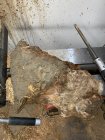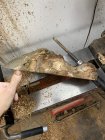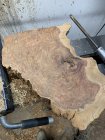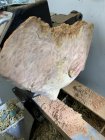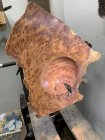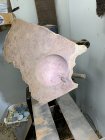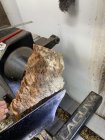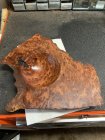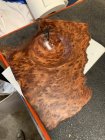-
December 2025 Turning Challenge: Single Tree! (click here for details) -
Congratulations to Bob Henrickson, People's Choice in the November 2025 Turning Challenge (click here for details) -
Congratulations to Steven Gordon for "Dropped Ice Cream Cone" being selected as Turning of the Week for December 8, 2025 (click here for details) -
Welcome new registering member. Your username must be your real First and Last name (for example: John Doe). "Screen names" and "handles" are not allowed and your registration will be deleted if you don't use your real name. Also, do not use all caps nor all lower case.
You are using an out of date browser. It may not display this or other websites correctly.
You should upgrade or use an alternative browser.
You should upgrade or use an alternative browser.
How would you mount this burl cap?
- Thread starter Daniel Warren
- Start date
Odie
Panning for Montana gold, with Betsy, the mule!
The most common way would be to turn it between centers to get a tenon......However:
Assuming you want the large flat area to be the top, you could use a face plate there and turn a tenon on the bottom.....Or, if you decide screw holes are not acceptable, gluing a waste block on the top could allow you to turn the tenon on the bottom. That is, if the moisture content is at an acceptable level to support glue adhesion.
Another possibility would be a very large Forstner bit that would allow a small faceplate to be mounted to the bottom using the flat spot created by it. I have a 3" Forstner bit for just this purpose, and this method works very well for mounting one of my 2 3/4" faceplates. This would require screw holes.....
Or.....if you can get a flat spot on the bottom with a belt sander, and reasonably flat with the top, a glue block could be attached there.....
Since there is no right or wrong way of doing it, as long as the mount is secure, I'm assuming others have utilized other methods of accomplishing this.....
-----odie-----
Assuming you want the large flat area to be the top, you could use a face plate there and turn a tenon on the bottom.....Or, if you decide screw holes are not acceptable, gluing a waste block on the top could allow you to turn the tenon on the bottom. That is, if the moisture content is at an acceptable level to support glue adhesion.
Another possibility would be a very large Forstner bit that would allow a small faceplate to be mounted to the bottom using the flat spot created by it. I have a 3" Forstner bit for just this purpose, and this method works very well for mounting one of my 2 3/4" faceplates. This would require screw holes.....
Or.....if you can get a flat spot on the bottom with a belt sander, and reasonably flat with the top, a glue block could be attached there.....
Since there is no right or wrong way of doing it, as long as the mount is secure, I'm assuming others have utilized other methods of accomplishing this.....
-----odie-----
seems to me 2 bowls at either end....one small & one larger....attach blank flat side to mdf with glue gun and straps...attach face plate to other side of mdf depending where u want axis for each bowl to be...add weights to mdf to run smoothly.....start at low rpms
Last edited:
Thanks. I think I’ll go with some shorter screws with a faceplate @odie. I believe it’s completely dry and is pretty light so shorter screws and a cautious approach should work. I’ll cut into two sections as per @Emiliano Achaval suggested. I’m not sure why but the mdf approach doesn’t appeal to me @charlie knighton but I appreciate it nonetheless. Will get some progress photos once I get to it.
john lucas
AAW Forum Expert
You can easily hot glue it to a wooden faceplate. You will have to glue in wedges all around. What I do is figure out where I want the bowl. Mark the center of that bowl. then bring up my tailstock and put that on the center. push it against the faceplate and then align the flatside perpendicular to the bed. Once you have it aligned start gluing wedges in. Once you have them glued then turn your bowl. To turn a smaller bowl in the other end you will need to make quite a few more wedges and possibly a block to raise it. You will also want to add some counter weight to the faceplate to keep the vibrations to a minimum. Might even run a strap across the larger portion to make it secure.
John, I am having a hard time visualizing the wedges you're talking about? Do you have a photo?
- Joined
- Jan 27, 2005
- Messages
- 13,176
- Likes
- 5,751
- Location
- Dalworthington Gardens, TX
- Website
- pbase.com
John, I am having a hard time visualizing the wedges you're talking about? Do you have a photo?
I would call them trapezoids rather than wedges. Think of them serving the same function as the rubber stoppers on Jumbo jaws (or Cole or Bowl depending on brand). You would want the wooden pieces to be narrow at the bottom and wide at the top to retain the irregular shaped burl.
The ways to hold it are only limited by the imagination. I had a similar problem once and didn't want to mar the rough exterior so I made a mold to fit the shape and the mold was held in the jaws of a chuck.
Odie
Panning for Montana gold, with Betsy, the mule!
Think of them serving the same function as the rubber stoppers on Jumbo jaws
(The light bulb just turned on!)
You know, Bill.....This does bring up another possibility for mounting an uneven shape, such as that Daniel is contemplating. Those slots on the jumbo and mega jumbo jaws are made for mounting the rubber grippers to hold an irregular shape. It could be done, and therefore capable of turning a tenon on the bottom.....
-----odie-----
john lucas
AAW Forum Expert
I will dig. I might but really I just cut wedges from scrap(think something that looks like a door stop). I just kind of visualize how bit of a tapered wedge I need and cut it. Since it's wedge shaped and the wood sort of forms a tapered pocket due to it's shape it's easy to fit them in. They only need to touch in a one spot. Then fill the gap with hot glue. Any kind of scrap pieces you have will work. I usually have short scrapes of pine from other projects so I just go to the bandsaw and cut. I have something that resembles a burl in the shop. I'll go put it on the lathe and cut a wedge so you can see. I'm not going to glue it in because I don't know what I will do with this piece at this time but you'll get the idea. Give me a few minutes to finish breakfast. OK had time to get a shot real quick. You can of course align the flat side any way you want. It doesn't have to be flat with the tailstock. If you mount the burl off center I would not trust the glue alone. I use webbing strap. I screw one part into my faceplate, wrap the web across and then screw the second side down. If necessary I will put another screw in to pull the web tight. I usually use washers on the screws so the heads don't pull through.
Attachments
Last edited:
John, are you thinking to first do the inside of the bowl in this position? How would you mount it to do the outside? I have a similar piece that l was planning to mount the flat side with a worm screw to do the outside first. If necessary, l was going to use a forstner bit to help me form a recess to reverse mount the piece. l would drill just deep enough to more easily deal with the uneven surface; so, l wouldn't need to contend with the center point hole in the bottom of the finished bowl. I'm just a beginner. Experience has been my best teacher. I'm putting my idea out there in the hope that my burl cap doesn't fall victim to another of my learning experiences.
john lucas
AAW Forum Expert
Most of those I have done with very little turning on the outside. I turn the inside first. Then make a jam chuck and put the piece on that with the tailstock in place then i can turn the outside if necessary. I often use a vacuum chuck but if your new to turning you probably don't have one of those. Once you've turned 90 percent of the bottom you can use tape or stretch wrap to hole the bowl to the jam chuck and remove the tailstock to turn the rest. I have done it back wards. Hot glue the flat side to the faceplate to the the bottom first. Sometimes you still have to use shims to fasten it to the faceplate securely and I would always use the tailstock as long as possible.
Looking like more ways to accomplish this than I’d imagined. Glad to have the options!
Beautiful grain in that piece. Good luck with turning it. Looking forward to seeing how you mount it and see the finished bowl.
Having a flat surface to work off of you can always glue a larger block of wood that has a tenon on it to mount in your chuck. Another simple method is to use a metal ring with short screws that your chuck fits into to support the wood blank. Once the piece is mounted on the lathe you can then bring the tailstock up with a face plate or other mounting apparatus and properly align and mount the odd shaped contour of the bottom of the bowl to it or simply turn a tenon or recess on the wood blank depending on what you want for a finished bowl design. This ends up being a two or three step process but you end up with more of the original wood when starting with a limited depth of billet to start with.
Most of those I have done with very little turning on the outside. I turn the inside first. Then make a jam chuck and put the piece on that with the tailstock in place then i can turn the outside if necessary. I often use a vacuum chuck but if your new to turning you probably don't have one of those. Once you've turned 90 percent of the bottom you can use tape or stretch wrap to hole the bowl to the jam chuck and remove the tailstock to turn the rest. I have done it back wards. Hot glue the flat side to the faceplate to the the bottom first. Sometimes you still have to use shims to fasten it to the faceplate securely and I would always use the tailstock as long as possible.
Here’s the next question- what would you finish it with, and why?
I have Formby’s satin and gloss tung oil “finish” currently.
I have Formby’s satin and gloss tung oil “finish” currently.
Attachments
Odie
Panning for Montana gold, with Betsy, the mule!
Here’s the next question- what would you finish it with, and why?
I have Formby’s satin and gloss tung oil “finish” currently.
That's going to turn out well, Daniel
Would you mind showing us how you mounted it? Thanks.......
I use Danish Oil Natural for just about everything. Easy to use, and nice satin sheen that looks good. For something like that, I pour some in a disposable paper bowl, and use a disposable brush to get into all the crevices, and voids. Something like that might take more than one application, but most smooth grained bowls just take a single very liberal application.
-----odie-----

